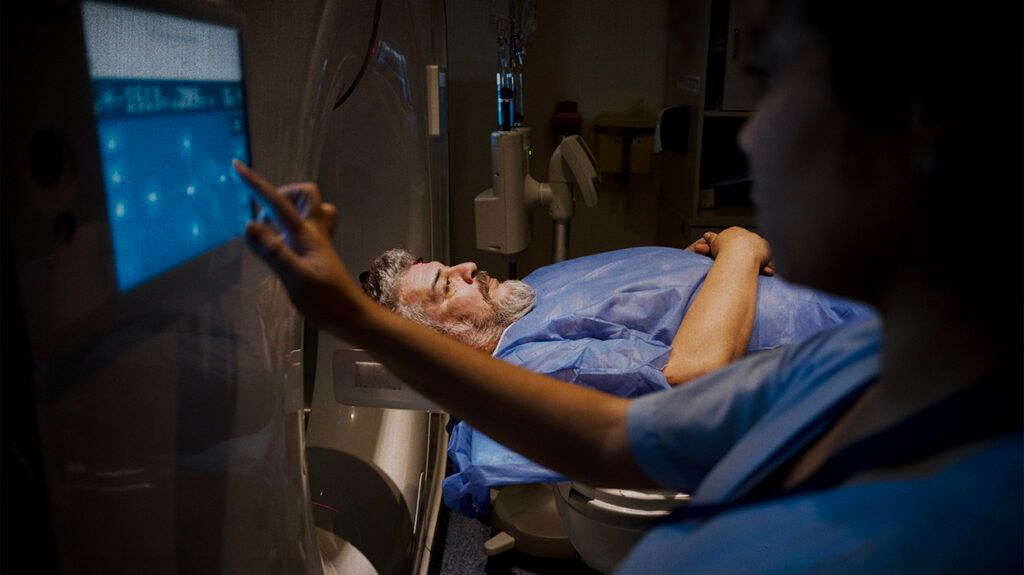Post-vasectomy pain syndrome is testicular pain that can occur after having a vasectomy. The pain lasts for 3 months or longer and affects daily activities.
Post-vasectomy pain syndrome (PVPS) is pain in one or both testicles that can be constant or can come and go. It can last for 3 months or longer and affects everyday activities.
This article explores how common PVPS is, symptoms, diagnosis, treatment, outlook, and when to contact a doctor.

The exact prevalence of PVPS is unknown.
According to the American Urological Association, PVPS affects 1 to 2 people out of 100 vasectomies. However, a 2020 review suggests PVPS might be more common, affecting 1% to 14% of those who undergo a vasectomy.
Signs and symptoms of PVPS include:
- persistent scrotal pain
- pain with ejaculation
- pain with physical activity
- painful sex
- a feeling of fullness of the vas deferens — the tube that carries the sperm out of the testicles
Symptoms of PVPS may develop after a vasectomy and may begin months later. The average time for the first symptoms to appear is
Experts are still unclear about the exact causes of PVPS. Theories
Risk factors
There is no apparent cause of PVPS, so it is unclear if there are any risk factors for it.
Surgical technique may play a role in post-vasectomy pain. A scalpel vasectomy may increase the incidence of post-vasectomy pain compared to non-scalpel vasectomy, although rates of PVPS may be similar with both procedures.
Authors of a 2020 literature review note that the incidence of post-vasectomy pain with scalpel vasectomy was 24% and 7% following non-scalpel vasectomy.
There is no set test for PVPS, so doctors may assess symptoms and carry out tests to rule out other conditions that can also cause pain in the testicles. This
- a physical examination
- a urine test
- a urine and semen culture, which examines the urine and semen for infection
- a screening for B12 and testosterone deficiencies, which can be common with chronic testicular pain
- an ultrasound of the scrotum
- an abdominal-pelvic CT scan to check for inguinal hernias, aneurysms, or kidney stones in the ureters
- a spinal MRI if people also have back or hip pain
Treatment for PVPS may include medication or complementary treatments to help relieve pain,
- nonsteroidal anti-inflammatory drugs (NSAIDs)
- tricyclic antidepressants (TCAs)
- gabapentin, a type of nerve pain medication
- local or regional nerve blocks
- acupuncture
The first-line treatment for PVPS is usually NSAIDs for 4 to 6 weeks. If these are ineffective at relieving pain, second-line drug therapies may include TCAs or gabapentin.
If medications are not effective, people may require surgical treatment. This may include:
- vasectomy reversal, which reconnects the vas deferens
- epididymectomy, which refers to surgery to remove the epididymis
- microsurgical denervation of the spermatic cord (MDSC), or cord stripping, which removes the nerves of the spermatic cord to relieve pain
- orchiectomy, which is surgery to remove the testicles, which may be a last resort treatment
Ways to help manage post-vasectomy pain
- Wearing supportive underwear: Wearing compression shorts or a jock strap may help manage testicular pain.
- Applying ice or heat: Applying an ice pack or a hot compress to the area may help manage pain. People may also find it helpful to sit in a warm bath.
- Physical therapy: Pelvic floor exercises may help with symptoms. People may want to talk with a physical therapist specializing in pelvic area conditions.
- Complementary therapies: Treatments such as acupuncture may help with pain management.
Medications and complementary therapies
If these treatments do not work, surgery may be an effective option. In many cases, people with PVPS are free from pain after surgery and report satisfaction with the treatment outcome.
There is no guaranteed way to prevent post-vasectomy pain syndrome. A person can speak with a doctor about their concerns before the procedure.
Without treatment, PVPS can interfere with daily living. Chronic pain can
People can contact their doctor if they have symptoms of PVPS after having a vasectomy. A doctor can assess symptoms, rule out other conditions, and suggest treatment options.
There is a slight risk of bleeding in the scrotum or infection following a vasectomy. People need to contact a doctor straight away if they have any of the following symptoms following a vasectomy:
- scrotal pain
- an enlarged scrotum
- a red, discolored, or sore scrotum
- fever
Before undergoing a vasectomy, people may wish to discuss the following questions with a doctor:
- What are the possible side effects, risks, and complications?
- What are the benefits of the procedure?
- How invasive is the procedure?
- Is it reversible?
- What are the success and failure rates of the procedure?
- How do I prepare for surgery?
- How long is recovery?
- What treatments are there for possible complications?
- Are there follow-up appointments post-vasectomy?
- Are there ways to minimize the risk of post-vasectomy pain syndrome?
Post-vasectomy pain syndrome (PVPS) is persistent testicular pain following a vasectomy that lasts for 3 months or longer. Symptoms may include scrotal pain, pain during sex, and pain with physical activity.
Treatment for PVPS may help relieve pain. Medications and complementary therapies may treat symptoms, but in some cases, people may require surgical treatment.